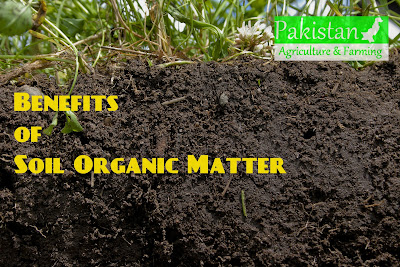Organic matter is considered the most valuable
asset for the agricultural soil with regard to its use in crop production and
landscaping. Here is a brief list of benefits from the presence of different sources
of organic matter in the soil;
 |
| Benefits of Soil Organic Matter (Article cover) |
1.
Darker soils warm up faster in spring season. (Darker color of the soil is due to presence of humus and other types
of organic matter.)
2.
Dead organisms (plants and animals) in the soils are converted to mineral and
humus by the action of living organisms (bacteria and fungi).
3.
Decomposition of the organic matter in the soil provides a source of slow
release fertilizer.
4.
Dead organic matter is the source of food for soil microbes and increases their
activity.
5.
Aeration in the soil is improved by the presences of recognizable dead organic
matter; it also opens up the soil physically.
6.
Fine unrecognizable organic matter has good effect on the water holding
capacity of the soil.
7.
Humus in the soil forms a coat around soil particles in with a black colloid
and improves the soil characteristics.
 |
| Crumbs clearly visible in soil with high organic matter contents |
8.
Crumbs are easily formed on sandy and silty soils when humus is present.
9.
The surface charge of humus combines the clay particles and thus makes heavy
soil lesser sticky and more crumbly.
10.
Atmospheric nitrogen is fixed by nitrogen fixing rhizobia and azobacter in soil.
11.
Earthworms, plant roots and other burrowing insects improves the soil structure.
12.
Bacteria in soil are effective in detoxifying many insecticides and herbicides.
13.
Cation exchange capacity (CEC) of the soils is also increased and thus the
leaching of cation from the soil profile is reduced.

